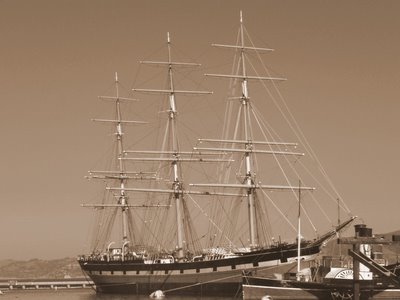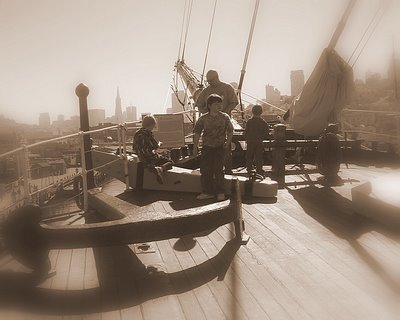SV Balclutha

| Overall length | 301 feet |
| Length of deck | 256.5 feet |
| Beam | 38.6 feet |
| Depth | 22.7 feet |
| Gross tonnage | 1689 |
| Height of mainmast | 145 feet |
"A friend of my father was a ship broker at Cardiff, so being there at the time, I asked him what chance I had of getting such a trip. His answer was, ‘We are brokers for a new ship loading coal at Penarth for San Francisco, and she will sail this week. She is a ship called Balclutha and we can get you a berth …’"
"… we were towed away from the dock soon after we joined her … we headed down the Bristol Channel and Irish Sea under full sail. You may guess how I felt up aloft on a topsail furling sail. I don’t know that I had ever been on a yardarm before, but I had to … ."
Excerpted from a letter by Captain Norman Pearce, chronicling his experience as an able-bodied seaman on Balclutha's maiden voyage.
The full rigged Ship Balclutha has seen several carreers prior to her current berth with the national park service.
She was launched under the british flag as a Deepwaterman in 1886, and on January 15, 1887, with a twenty-six-man crew, Balclutha sailed under British registry from Cardiff, Wales, on her maiden voyage. She was bound for San Francisco. The ship entered the Golden Gate after 140 days at sea, unloaded her cargo of 2,650 tons of coal, and took on sacks of California wheat.
Because of the months-long ocean voyage, Balclutha made only one round-trip per year while engaged in the Europe-to-San Francisco grain trade. She arrived with a cargo three times, but also brought pottery, cutlery, Scotch whisky (from Glasgow and Liverpool) and "Swansea general" (tinplate, coke and pig iron) to San Francisco.
During the mid-1890s the ship called at other ports around the world; in New Zealand, for example, she loaded wool and tallow for London, England.

In 1899 Balclutha was transferred to Hawaiian registry, and she joined the bustling Pacific Coast lumber trade. For three years the ship sailed north to Puget Sound, Washington, and then across to Australia. Much of the 1.5 million board feet she could carry ended up underground, used for mining timbers in the Broken Hill Mine at Port Pirie, Australia.
Balclutha was the last vessel to fly the flag of the Hawaiian Kingdom. In 1901 a special act of the United States Congress admitted the ship to American registry so that she could engage in "coastwise" trade (i.e. between American ports). Soon thereafter, the Alaska Packers Association, a San Francisco firm which harvested and canned salmon, chartered her to carry men and supplies north – to Alaska.

When Balclutha went aground in 1904, the Alaska Packers Association purchased her where she lay for the non-princely sum of $500. After extensive repairs, they renamed her Star of Alaska (all Packer iron and steel sailing vessels had a "Star" prefix to their names).
During this career, the ship sailed up the West Coast from Alameda, California, carrying supplies and cannery workers. Star of Alaska anchored out in Chignik Bay, Alaska, during April. After the supplies were unloaded and the cannery workers had settled into the company’s camp ashore, only a shipkeeper or two remained on board. In early September, her hold packed with cases of canned salmon, Star of Alaska started the 2,400-mile voyage back to San Francisco Bay. She was considered a fast sailer, averaging better than twenty-two days for the trip north and fifteen days when homeward bound.
During the winter the ship was laid up with the rest of the Packer’s fleet of thirty-odd vessels in Alameda, where shipwrights performed maintenance and renovation. In 1911, the poop deck was extended to house Italian and Scandinavian fishermen. Later, additional bunks were added in the ‘tween deck for Chinese cannery workers. As Balclutha, the ship carried a crew of twenty-six men; on Star of Alaska, over 200 men made the trip north.
Star of Alaska was the only sailing ship the Packers sent north in 1930, and when she returned that September she, too, was retired.
He rcareer as a movie star began when Frank Kissinger purchased Star of Alaska in 1933 (for $5,000) and renamed her Pacific Queen. Kissinger took the ship south and, while anchored off Catalina Island, she appeared in the film Mutiny on the Bounty (Clark Gable and Charles Laughton also appeared in supporting roles). For a time thereafter, Kissinger towed her up and down the West Coast, usually exhibiting her as a "pirate ship." Pacific Queen slowly deteriorated, and she barely escaped the World War II scrap metal drives.
In 1954 the San Francisco Maritime Museum purchased Pacific Queen for $25,000. Assisted by donations of cash, materials and labor from the local community, the Museum restored the vessel and returned her original name. The ship was transferred to the National Park Service in 1978, and Balclutha was designated a National Historic Landmark in 1985.


0 Comments:
Post a Comment
<< Home